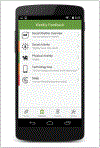Development and Evaluation of a Smartphone-Based Measure of Social Rhythms for Bipolar Disorder
- PMID: 27358214
- PMCID: PMC6155452
- DOI: 10.1177/1073191116656794
Development and Evaluation of a Smartphone-Based Measure of Social Rhythms for Bipolar Disorder
Abstract
Dynamic psychological processes are most often assessed using self-report instruments. This places a constraint on how often and for how long data can be collected due to the burden placed on human participants. Smartphones are ubiquitous and highly personal devices, equipped with sensors that offer an opportunity to measure and understand psychological processes in real-world contexts over the long term. In this article, we present a novel smartphone approach to address the limitations of self-report in bipolar disorder where mood and activity are key constructs. We describe the development of MoodRhythm, a smartphone application that incorporates existing self-report elements from interpersonal and social rhythm therapy, a clinically validated treatment, and combines them with novel inputs from smartphone sensors. We reflect on lessons learned in transitioning from an existing self-report instrument to one that involves smartphone sensors and discuss the potential impact of these changes on the future of psychological assessment.
Keywords: IPSRT; behavioral sensing; bipolar disorder; ecological momentary assessment; mHealth; mental health; self-report.
Conflict of interest statement
Declaration of Conflicting Interests
The author(s) declared the following potential conflicts of interest with respect to the research, authorship, and/or publication of this article: M.M., E.F., and T.C. co-founded and have equity interest in HealthRhythms. G.G. serves on the advisory board for HealthRhythms.
Figures
Similar articles
-
[Interpersonal and social rhythm therapy (IPSRT)].Encephale. 2010 Dec;36 Suppl 6:S206-17. doi: 10.1016/S0013-7006(10)70059-2. Encephale. 2010. PMID: 21237358 Review. French.
-
[Psychoeducation and interpersonal and social rhythm therapy for bipolar disorder].Seishin Shinkeigaku Zasshi. 2011;113(9):880-5. Seishin Shinkeigaku Zasshi. 2011. PMID: 22117393 Review. Japanese.
-
Right care, first time: a highly personalised and measurement-based care model to manage youth mental health.Med J Aust. 2019 Nov;211 Suppl 9:S3-S46. doi: 10.5694/mja2.50383. Med J Aust. 2019. PMID: 31679171
-
Interpersonal and social rhythm therapy: an intervention addressing rhythm dysregulation in bipolar disorder.Dialogues Clin Neurosci. 2007;9(3):325-32. doi: 10.31887/DCNS.2007.9.3/efrank. Dialogues Clin Neurosci. 2007. PMID: 17969869 Free PMC article. Review.
-
Two-year outcomes for interpersonal and social rhythm therapy in individuals with bipolar I disorder.Arch Gen Psychiatry. 2005 Sep;62(9):996-1004. doi: 10.1001/archpsyc.62.9.996. Arch Gen Psychiatry. 2005. PMID: 16143731 Clinical Trial.
Cited by
-
Mindcraft, a Mobile Mental Health Monitoring Platform for Children and Young People: Development and Acceptability Pilot Study.JMIR Form Res. 2023 Jun 26;7:e44877. doi: 10.2196/44877. JMIR Form Res. 2023. PMID: 37358901 Free PMC article.
-
Personalized digital intervention for depression based on social rhythm principles adds significantly to outpatient treatment.Front Digit Health. 2022 Sep 2;4:870522. doi: 10.3389/fdgth.2022.870522. eCollection 2022. Front Digit Health. 2022. PMID: 36120713 Free PMC article.
-
Opportunities for digital health technology: identifying unmet needs for bipolar misdiagnosis and depression care management.Front Digit Health. 2023 Sep 12;5:1221754. doi: 10.3389/fdgth.2023.1221754. eCollection 2023. Front Digit Health. 2023. PMID: 37771820 Free PMC article.
-
Smartphone-based activity tracking for spine patients: Current technology and future opportunities.World Neurosurg X. 2023 Oct 1;21:100238. doi: 10.1016/j.wnsx.2023.100238. eCollection 2024 Jan. World Neurosurg X. 2023. PMID: 38221955 Free PMC article. Review.
-
Health Tracking via Mobile Apps for Depression Self-management: Qualitative Content Analysis of User Reviews.JMIR Hum Factors. 2022 Nov 23;9(4):e40133. doi: 10.2196/40133. JMIR Hum Factors. 2022. PMID: 36416875 Free PMC article.
References
-
- Abdullah S, Matthews M, Murnane EL, Gay G, & Choudhury T (2014, September). Towards circadian computing: Early to bed and early to rise makes some of us unhealthy and sleep deprived Paper presented at the Proceedings of the 2014 ACM International Joint Conference on Pervasive and Ubiquitous Computing, Seattle, WA.
-
- Altman E (1998). Rating scales for mania: Is self-rating reliable? Journal of Affective Disorders, 50, 283–286. - PubMed
-
- Altman EG, Hedeker DR, Janicak PG, Peterson JL, & Davis JM (1994). The Clinician-Administered Rating Scale for Mania (CARS-M): Development, reliability, and validity. Biological Psychiatry, 36, 124–134. - PubMed
-
- Baldessarini RJ, & Tondo L (2003). Suicide risk and treatments for patients with bipolar disorder. Journal of the American Medical Association, 290, 1517–1519. - PubMed
Publication types
MeSH terms
Grants and funding
LinkOut - more resources
Full Text Sources
Other Literature Sources
Medical





